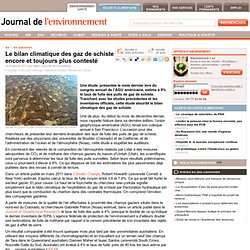

A Big Fracking Lie - Bill McKibben and Mike Tidwell - POLITICO Magazine. If you want to know just how bad an idea it is for America to ship “fracked” natural gas to overseas markets, travel the 65 miles from the White House to a place called Cove Point in southern Maryland.

There, right on the Chesapeake Bay, the Obama administration wants to give fast-track approval to a $3.8 billion facility (12 times the cost of the NFL Ravens stadium) to liquefy gas from all across Appalachia. The new plant, proposed by Virginia-based Dominion Resources, would somehow be built right between a coveted state park and a stretch of sleepy beach communities, with a smattering of Little League baseball fields just down the road. Along the Chesapeake itself, endangered tiger beetles cling to the shore while Maryland “watermen” hunt crabs and oysters in age-old fashion. Right here, Dominion wants build a utility-scale power plant (130 megawatts) just to power the enormous “liquefaction” process for the fracked gas.
EDF defends its controversial study of methane leaks from fracking wells. I am not a scientist and I don’t play one on the blogosphere.

My background is in grassroots organizing and communications. And for the last decade, I have been honored beyond words to be part of Environmental Defense Fund. I get to wake up every morning thinking of ways to advocate for my two young kids and their generation’s future by mobilizing public support for solutions to the world’s biggest environmental threats. And no threat is more urgent than climate change, a fact that has inspired EDF to make solving the climate crisis our No. 1 top priority issue for as long as I’ve been here. Right now, one of the most important climate concerns is the issue of fugitive emissions — specifically methane leaking from the natural gas supply chain. The problem is that right now there is very little hard data to go on to say with any confidence what the extent of the natural gas industry’s methane leakage problem is, or even where in the supply chain methane is leaking. Greenwashing Fracking’s Devastating Climate Impact. Gangplank to a Warm Future.
As a longtime and gas engineer who helped develop shale fracking techniques for the Energy Department, I can assure you that this gas is not “clean.” Because of leaks of methane, the main component of natural gas, the gas extracted from shale deposits is not a “bridge” to a renewable energy future — it’s a gangplank to more warming and away from clean energy investments.
Methane is a far more powerful greenhouse gas than carbon dioxide, though it doesn’t last nearly as long in the atmosphere. Still, over a 20-year period, one pound of it traps as much heat as at least 72 pounds of carbon dioxide. Its potency declines, but even after a century, it is at least 25 times as powerful as carbon dioxide. When burned, natural gas emits half the carbon dioxide of coal, but methane leakage eviscerates this advantage because of its heat-trapping power. And methane is leaking, though there is significant uncertainty over the rate. Tar sands exploitation would mean game over for climate, warns leading scientist. Major international oil companies are buying off governments, according to the world's most prominent climate scientist, Prof James Hansen.

During a visit to London, he accused the Canadian government of acting as the industry's tar sands salesman and "holding a club" over the UK and European nations to accept its "dirty" oil. "Oil from tar sands makes sense only for a small number of people who are making a lot of money from that product," he said in an interview with the Guardian. "It doesn't make sense for the rest of the people on the planet. We are getting close to the dangerous level of carbon in the atmosphere and if we add on to that unconventional fossil fuels, which have a tremendous amount of carbon, then the climate problem becomes unsolvable.
" Hansen met ministers in the UK government, which the Guardian previously revealed has secretly supported Canada's position at the highest level. Gaz de schiste: La fracturation hydraulique, pas si polluante qu'on le pensait?
Le gaz de schiste: une énergie propre? On peut diviser les risques environnementaux en trois grandes catégories : les dérangements pour la population et l’environnement associés à l’activité industrielle elle-même : forage, fracturation, passage de camions-citernes et exploitation d’un combustible gazeux en général, les risques associés à l’eau, allant de la contamination des eaux souterraines au traitement des eaux usées, la contribution aux changements climatiques de ces gaz. 1.

Gaz de schiste : autant d'émissions de CO2 que le charbon ou le pétrole (étude. Hydrocarbon emissions characterization in the Colorado Front Range: A pilot study. Bridge To Nowhere? NOAA Confirms High Methane Leakage Rate Up To 9% From Gas Fields, Gutting Climate Benefit. By Joe Romm "Bridge To Nowhere?

NOAA Confirms High Methane Leakage Rate Up To 9% From Gas Fields, Gutting Climate Benefit" Photo by Walter Disney Researchers with the National Oceanic and Atmospheric Administration (NOAA) have reconfirmed earlier findings of high rates of methane leakage from natural gas fields. If these findings are replicated elsewhere, they would utterly vitiate the climate benefit of natural gas, even when used to switch off coal.
Indeed, if the previous findings — of 4% methane leakage over a Colorado gas field — were a bombshell, then the new measurements reported by the journal Nature are thermonuclear: … the research team reported new Colorado data that support the earlier work, as well as preliminary results from a field study in the Uinta Basin of Utah suggesting even higher rates of methane leakage — an eye-popping 9% of the total production. The Uinta Basin is of particular interest because fracking has increased there over the past decade. Le bilan climatique des gaz de schiste encore et toujours plus contesté. Les gaz de schiste: un bilan carbone aussi noir que celui du charbon.

Une étude, présentée le mois dernier lors du congrès annuel de l’AGU américaine, estime à 9% le taux de fuite des puits de gaz de schiste. Tranchant avec les études précédentes et les inventaires officiels, cette étude alourdit le bilan climatique des gaz de schiste. Une de plus. Au début du mois de décembre dernier, nous rappelle Nature dans sa dernière édition, l’union géophysique américaine (AGU) tenait son colloque annuel à San Francisco.